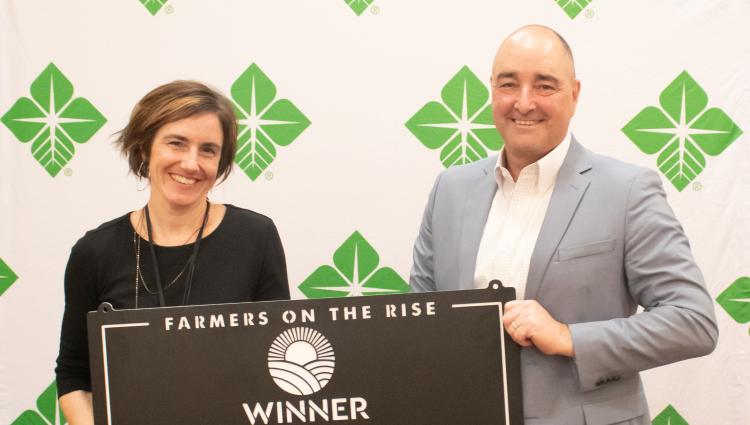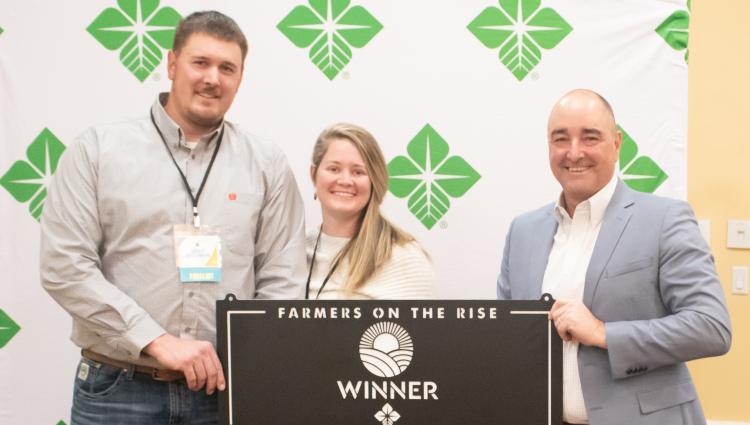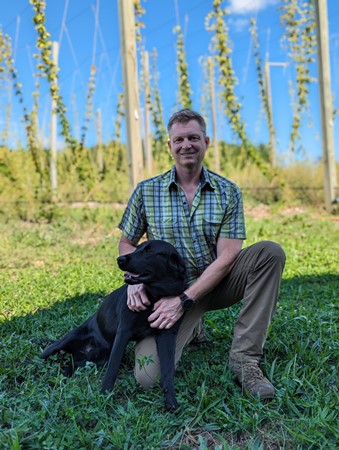Newsroom
Farmer on the Rise, Megan Bogle

Farm Credit awarded a total of $100,000 to beginning farmers through the Farmers on the Rise Award Program on December 7, 2023. Megan Bogle of Chester County, PA is one of ten recipients.
Megan began farming in 2018. She owns and operates True North Farmstead, which is a small-scale family run sheep farm and dairy, raising East Friesian/Lacaune sheep. Megan produces artisan farmstead sheep’s cheese, pasture raised spring lamb meat, wool products, and seasonal batches of hot sauce. She sells direct to consumers at the Growing Roots Farmers’ Markets in Chester County and has seen a strong demand for her artisan cheeses continue to grow—and plans to expand her cheesemaking as a result.
Megan is planning to add a laboratory to the farm, so that each batch of milk processed for cheesemaking can be tested. Her operation is currently exempt from the Pasteurized Milk Ordinance (PMO) for antibiotic testing, but in order to expand, she will need to bring in milk from neighboring farms to supplement current operations, which will require the addition of a testing lab on site. Acquiring the lab will allow for growth and year-round market and cheesemaking activity.
You can meet all of the 2023 award winners here, and learn more about their farming experience on our blog!
Please enter a valid password to access this page:
Wrong password. Try again!Newsroom
Farmers on the Rise, Bradley & Kacie Bachman

Farm Credit awarded a total of $100,000 to beginning farmers through the Farmers on the Rise Award Program on December 7, 2023. Bradley and Kacie Bachman of Lebanon County, PA are one of ten recipients.
Bradley and Kacie Bachman jointly operate Bachman Equine LLC, an equine recovery facility in Lebanon County, Pennsylvania. Their operation, founded in 2018, offers specialized medical care and attention for horses requiring a quiet environment to rest, heal, and rejuvenate. They collaborate with owners and veterinarians to provide much-needed lay-up services for racehorses and brood mares to decompress and recuperate from physically demanding lifestyles. Kacie holds a veterinary technician license and draws upon experience gained while working in equine vet practices to care for her boarders.
They are planning to upgrade their bank barn by installing automatic, heated waterers, which would provide a consistent supply of fresh, temperature regulated water as well as reduce the workload of filling tubs with hoses and breaking ice during winter months. Additionally, Kacie and Bradley would like to purchase two large hay feeders for their horses to use during turnout. The feeders simulate natural grazing habits through a slow-feed process that also greatly reduces hay waste.
reduce the workload of filling tubs with hoses and breaking ice during winter months. Additionally, Kacie and Bradley would like to purchase two large hay feeders for their horses to use during turnout. The feeders simulate natural grazing habits through a slow-feed process that also greatly reduces hay waste.
You can meet all of the 2023 award winners here, and learn more about their farming experience on our blog!
Please enter a valid password to access this page:
Wrong password. Try again!Newsroom
Farmer on the Rise, Ian Antons

Farm Credit awarded a total of $100,000 to beginning farmers through the Farmers on the Rise Award Program on December 7, 2023. Ian Antons of Frederick County, VA is one of ten recipients.
Ian began farming in 2019, and owns 15 acres where he produces American heirloom hops for local breweries using no-till farming practices. Ian oversees all aspects of the farm's management, from cultivation to business development. His experiences as a combat veteran and a professional firefighter have contributed to a work ethic and resolve that have proven to be useful in agriculture. Through extensive research and networking, as well as trial and error, Ian has learned the intricacies of hop cultivation, how to manage soil health, prevent pest and disease issues, and select varietals. 
His short-term goals are to increase hop cone yield through farming technique optimization, nutrient management, and enhanced plant health. He also aims to expand his partnerships with nearby breweries with a goal of serving a broader regional market and to offer consumer education through workshops and tours. Long term, Ian plans to expand the farm's footprint and venture into value-added products such as on-site hop palletization, which would reduce reliance on other regional farms. He is seeking funds to purchase a hop harvesting machine, which would allow him to move away from manually harvesting his crop, thereby greatly increasing efficiency and optimizing labor resources.
You can meet all of the 2023 award winners here, and learn more about their farming experience on our blog!
Please enter a valid password to access this page:
Wrong password. Try again!Newsroom
Farm Credit Awards $100,000 through its Annual Farmers on the Rise Program

Farm Credit recently announced the ten recipients of their 2023 Farmers on the Rise program, awarding a total of $100,000 to beginning farmers in their territory. The following agriculturalists received this year’s honor:
- Ian Antons, Winchester VA
- Bradley and Kacie Bachman, Jonestown, PA
- Megan Bogle, Downingtown, PA
- Jarrod and Becky Burall, Mt. Airy, MD
- Tyler and Katie Fraser, New Bethlehem, PA
- Jennifer and Richard Hartlieb Jr., Robesonia, PA
- Julie Henninger, Gardners, PA
- Duy Pham, Princess Anne, MD
- Henry Spies V, Preston, MD
- Eric and Elizabeth Ziegler, Lebanon, PA
“We were pleased to receive over 74 applications this year, from agricultural producers located across our 100 county footprint,” says Tom Truitt, CEO of Horizon Farm Credit. “The applicants’ backgrounds, farms, products, and plans for growth were highly diverse, however, three themes were consistent throughout: a desire to serve their local communities, a passion for farming, and a commitment to environmental stewardship.” He went on to say, “All of this year’s applicants were truly impressive. We are honored to support this year’s Farmers on the Rise recipients as they look to grow their businesses and expand their local impact.”
Pennsylvania Agriculture Secretary Russell Redding was on hand to address the program’s finalists, congratulate this year’s honorees, and to provide perspective on the future of agriculture. “Beginning farmer programs feed the continued vitality of our farming communities,” he said. “Through programs like Farmers on the Rise, Horizon Farm Credit is sending a strong signal – we believe in the future of agriculture, and we believe investing in our farmers will cultivate a robust and dynamic agricultural sector that is empowered to thrive.
The contest was open to applicants with at least three but no more than 10 years of farming experience. To learn more about the program, visit farmersontherise.com.
Please enter a valid password to access this page:
Wrong password. Try again!As the leading farm and agriculture financial experts, our loan specialists know how to guide you through the ins and outs of getting an agriculture business loan.
The Farm Credit System, which includes Horizon, is a network of cooperatives owned by its borrowers (farmers, ranchers, agricultural cooperatives, and rural customers), representing more than 40% of all U.S. agricultural lending with assets valued at $289 billion. We're regulated and examined by the Farm Credit Administration.
Newsroom
Horizon Farm Credit Announces 2023 Third Quarter Financial Results
Horizon Farm Credit has announced its 2023 third quarter financial results. Net accruing loan volume for the first nine months of 2023 was $6.4 billion, an increase of 9.3 percent compared to the same 2022 period. Net interest income for the third quarter of 2023 was $42.3 million, a 1.2 percent decrease from the same time period in 2022. Net income for the quarter was $29.2 million, a 15.9 percent decrease compared to the third quarter of 2022. The unfavorable impact of the 2023 third quarter results is principally related to a provision for allowance for credit losses recorded and increased operating expenses in the third quarter of 2023.
Nonaccrual loans decreased $1.7 million in the third quarter of 2023 to $30.8 million, compared to $32.5 million at December 31, 2022, and decreased $4.9 million compared to $35.7 million at September 30, 2022. The Association’s nonaccrual loans as a percentage of total loans decreased to 0.48 percent at the end of the third quarter of 2023 compared to 0.54 percent at the end of 2022, and 0.60 percent at the end of the third quarter of 2022.
“We continue to be pleased by our Association’s financial performance and hold a highly positive outlook, as we approach year-end,” said Tom Truitt, Chief Executive Officer. “Our Board of Directors and management team remains committed to ensuring that our cooperative is well positioned to serve the present and future needs of agriculture and rural communities,” he continued. “The sustained strong performance of our Association enables us to fulfill that important mission.”
Members’ equity at September 30, 2023 totaled $1.2 billion, up 4.0 percent from December 31, 2022. Total Capital Ratio was 16.21 percent as compared with the 10.5 percent minimum mandated by the Farm Credit Administration (FCA), the Association’s independent regulator. The Association paid a cash patronage distribution of $91 million to its member-borrowers in the first quarter of 2023.
Please enter a valid password to access this page:
Wrong password. Try again!Newsroom
Farm Credit Announces 2024 Ag Biz Masters Educational Program Registration
Farm Credit has announced that registration for Ag Biz Masters, the nationally recognized learning series for young and beginning farmers, is open now through December 15, 2023.
“Farmers are, by nature, lifelong learners,” says Tom Truitt, CEO of Horizon Farm Credit. “We’re pleased to support agricultural producers, not only with financing, grants, and awards, but also through educational opportunities, including our Ag Biz Masters program, which will benefit those seeking to break into the industry or expand their business knowledge.”
The two-year educational program is available to young, beginning, and small producers who are interested in refining their business management, financial, and marketing skills to help them as they launch or grow their businesses.
Ag Biz Masters blends virtual live and on-demand learning. The year one curriculum focuses on trends in agriculture, strategic business planning, financial management, and constructing both a balance sheet and income statement. Year two includes learning modules centered on understanding lending decisions, growth and transition management, personal financial management, and leadership skills.
“To date, we’ve had 730 students graduate from our Ag Biz Masters program,” says Johanna Rohrer, Horizon Farm Credit’s Member Education and YBS Program Manager. “Agriculture is a constantly changing industry, and we encourage all producers to take advantage of this opportunity to develop their business skills, just as they continue to advance their farming practices.”
The next Ag Biz Masters class begins in January 2024 and will run through April. The registration fee is $225, with full reimbursement available to those who successfully complete their registered year and live within the Horizon Farm Credit service area.
For more information about the Ag Biz Masters educational program, please visit agbizmasters.com, or contact Johanna Rohrer at 888.339.3334 or learning@horizonfc.com.